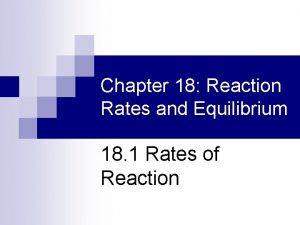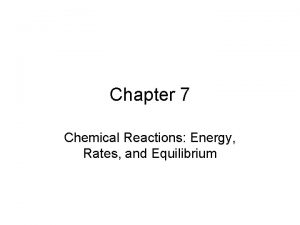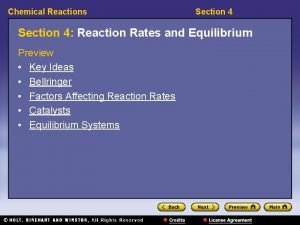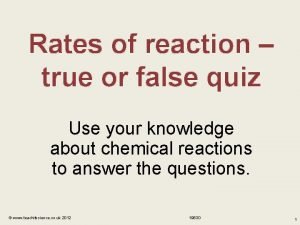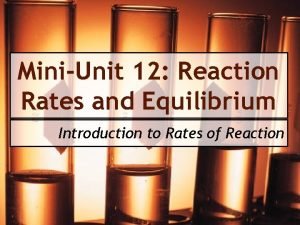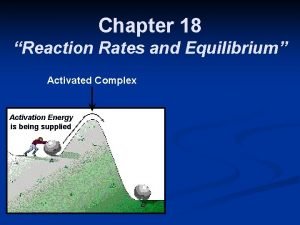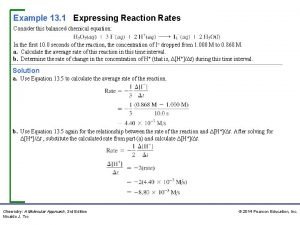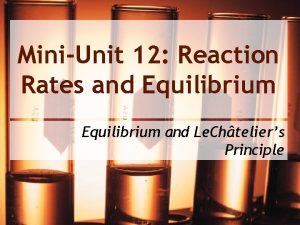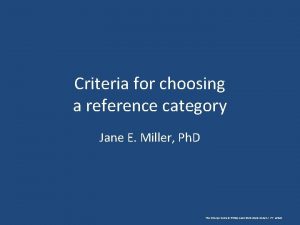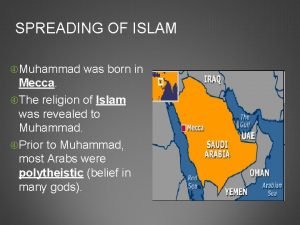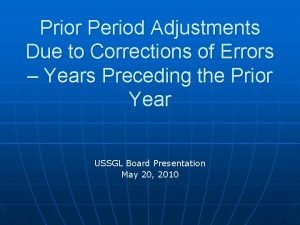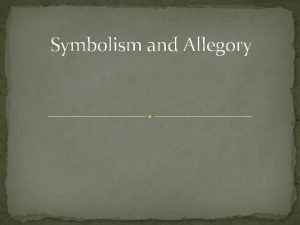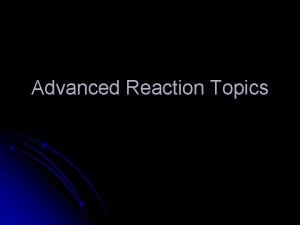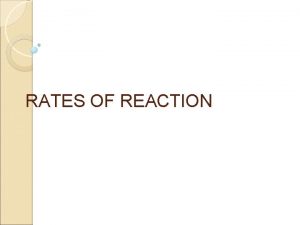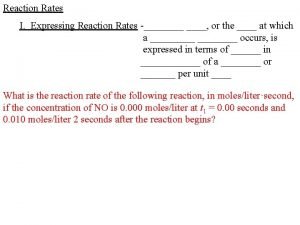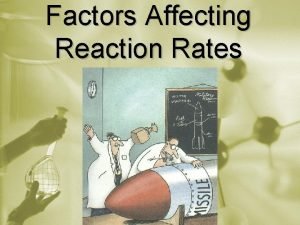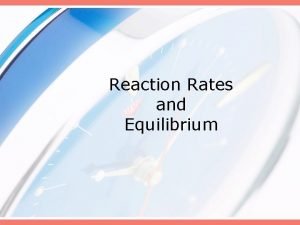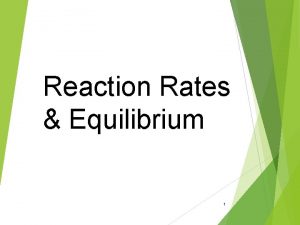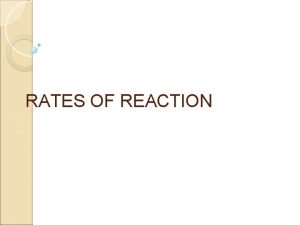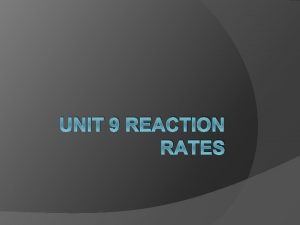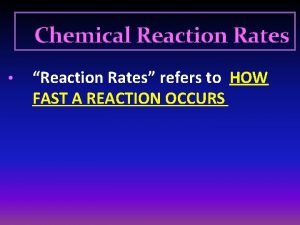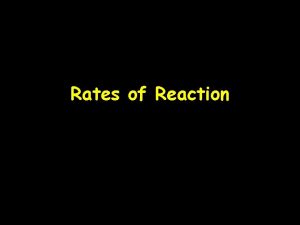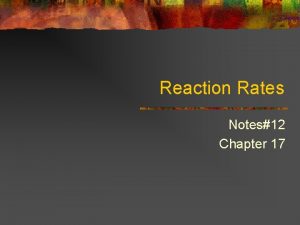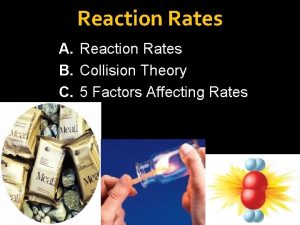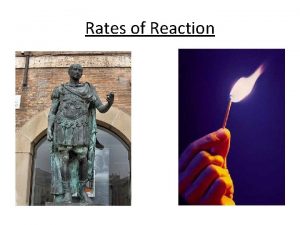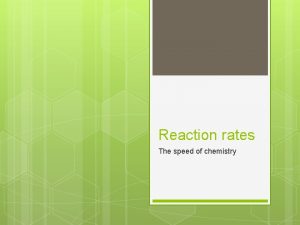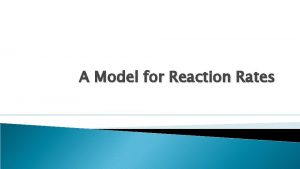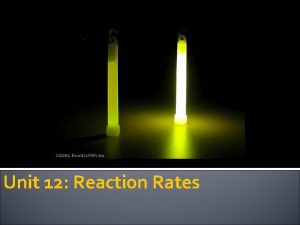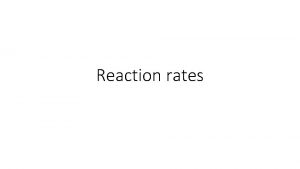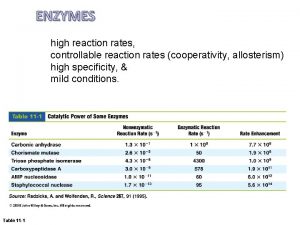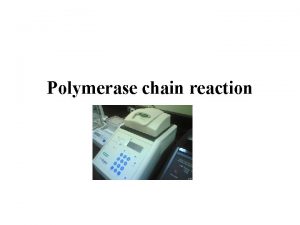RATES OF REACTION RATES OF REACTION CONTENTS Prior


























- Slides: 26

RATES OF REACTION

RATES OF REACTION CONTENTS • Prior knowledge • Collision Theory • Methods for increasing rate • Surface area • Temperature • Light • Catalysts • Pressure • Concentration • Check list

RATES OF REACTION Before you start it would be helpful to… • know how the energy changes during a chemical reaction • know the basic ideas of Kinetic Theory • know the importance of catalysts in industrial chemistry CONTENTS

CHEMICAL KINETICS Introduction Chemical kinetics is concerned with the dynamics of chemical reactions such as the way reactions take place and the rate (speed) of the process. In the following pages you will look at the QUALITATIVE and the QUANTITATIVE aspects of how the rate (speed) of a reaction can be changed. Chemical kinetics plays an important part in industrial chemistry because the time taken for a reaction to take place and the energy required are of great economic importance. The kinetic aspect of chemistry is often at odds with thermodynamic side when considering the best conditions for industrial production. The concepts met in this topic can be applied throughout the rest of the course when studying both theoretical and the practical aspects of chemistry. The basis of the study is COLLISION THEORY. . .

COLLISION THEORY Collision theory states that. . . • particles must COLLIDE before a reaction can take place • not all collisions lead to a reaction • reactants must possess at least a minimum amount of energy - ACTIVATION ENERGY plus • particles must approach each other in a certain relative way - the STERIC EFFECT

COLLISION THEORY Collision theory states that. . . • particles must COLLIDE before a reaction can take place • not all collisions lead to a reaction • reactants must possess at least a minimum amount of energy - ACTIVATION ENERGY plus • particles must approach each other in a certain relative way - the STERIC EFFECT According to collision theory, to increase the rate of reaction you therefore need. . . more frequent collisions increase particle speed have more particles present more successful collisions give particles more energy or lower the activation energy or

INCREASING THE RATE The following methods may be used to increase the rate of a chemical reaction • INCREASE THE SURFACE AREA OF SOLIDS • INCREASE TEMPERATURE • SHINE LIGHT • ADD A CATALYST • INCREASE THE PRESSURE OF ANY GASES • INCREASE THE CONCENTRATION OF REACTANTS

INCREASING SURFACE AREA • Increasing surface area increases chances of a collision - more particles are exposed • Powdered solids react quicker than larger lumps • Catalysts (e. g. in catalytic converters) are in a finely divided form for this reason + In many organic reactions there are two liquid layers, one aqueous, the other nonaqueous. Shaking the mixture improves the reaction rate as an emulsion is often formed and the area of the boundary layers is increased giving more collisions. 1 1 CUT THE SHAPE INTO SMALLER PIECES 3 1 1 3 SURFACE AREA 9+9+3+3 = 30 sq units SURFACE AREA 9 x (1+1+1+1) = 54 sq units

INCREASING TEMPERATURE Effect increasing the temperature increases the rate of a reaction particles get more energy so they can overcome the energy barrier particle speeds also increase so collisions are more frequent ENERGY CHANGES DURING A REACTION As a reaction takes place the enthalpy of the system rises to a maximum, then falls A minimum amount of energy is required to overcome the ACTIVATION ENERGY (Ea). Only those reactants with energy equal to, or greater than, this value will react. If more energy is given to the reactants then they are more likely to react. Typical energy profile diagram for an exothermic reaction

NUMBER OF MOLECUES WITH A PARTICULAR ENERGY INCREASING TEMPERATURE MAXWELL-BOLTZMANN DISTRIBUTION OF MOLECULAR ENERGY Because of the many collisions taking place between molecules, there is a spread of molecular energies and velocities. This has been demonstrated by experiment. It indicated that. . . no particles have zero energy/velocity some have very low and some have very high energies/velocities most have intermediate velocities.

NUMBER OF MOLECUES WITH A PARTICULAR ENERGY INCREASING TEMPERATURE MAXWELL-BOLTZMANN DISTRIBUTION OF MOLECULAR ENERGY T 1 T 2 TEMPERATURE T 2 > T 1 MOLECULAR ENERGY Increasing the temperature alters the distribution • get a shift to higher energies/velocities • curve gets broader and flatter due to the greater spread of values • area under the curve stays constant - it corresponds to the total number of particles

NUMBER OF MOLECUES WITH A PARTICULAR ENERGY INCREASING TEMPERATURE T 3 MAXWELL-BOLTZMANN DISTRIBUTION OF MOLECULAR ENERGY T 1 TEMPERATURE T 1 > T 3 MOLECULAR ENERGY Decreasing the temperature alters the distribution • get a shift to lower energies/velocities • curve gets narrower and more pointed due to the smaller spread of values • area under the curve stays constant - it corresponds to the total number of particles

NUMBER OF MOLECUES WITH A PARTICULAR ENERGY INCREASING TEMPERATURE T 3 MAXWELL-BOLTZMANN DISTRIBUTION OF MOLECULAR ENERGY T 1 T 2 TEMPERATURE T 2 > T 1 > T 3 MOLECULAR ENERGY REVIEW no particles have zero energy/velocity some particles have very low and some have very high energies/velocities most have intermediate velocities as the temperature increases the curves flatten, broaden and shift to higher energies

NUMBER OF MOLECUES WITH A PARTICULAR ENERGY INCREASING TEMPERATURE MAXWELL-BOLTZMANN DISTRIBUTION OF MOLECULAR ENERGY Ea NUMBER OF MOLECULES WITH SUFFICIENT ENERGY TO OVERCOME THE ENERGY BARRIER MOLECULAR ENERGY ACTIVATION ENERGY - Ea The Activation Energy is the minimum energy required for a reaction to take place The area under the curve beyond Ea corresponds to the number of molecules with sufficient energy to overcome the energy barrier and react.

INCREASING TEMPERATURE NUMBER OF MOLECUES WITH A PARTICULAR ENERGY TEMPERATURE MAXWELL-BOLTZMANN DISTRIBUTION OF MOLECULAR ENERGY T 2 > T 1 T 2 Ea EXTRA MOLECULES WITH SUFFICIENT ENERGY TO OVERCOME THE ENERGY BARRIER MOLECULAR ENERGY Explanation increasing the temperature gives more particles an energy greater than E a more reactants are able to overcome the energy barrier and form products a small rise in temperature can lead to a large increase in rate

SHINING LIGHT certain reactions only • shining a suitable light source onto some reactants increases the rate of reaction • the light - often U. V. - provides energy to break bonds and initiate a reaction • the greater the intensity of the light, the greater the effect Examples a) the reaction between methane and chlorine - see alkanes b) the darkening of silver salts - as used in photography c) the reaction between hydrogen and chlorine Equation H 2(g) + Bond enthalpies H-H 436 k. J mol-1 Mechanism Cl 2(g) ———> 2 Cl • H 2 + Cl • ——> H • + Cl 2 ——> HCl 2 Cl • 2 H • + Cl • ——> ——> Cl 2 HCl 2 HCl(g) Cl-Cl + + H • Cl • 242 k. J mol-1 ----- INITIATION ----- PROPAGATION ----- TERMINATION

ADDING A CATALYST • Catalysts provide an alternative reaction pathway with a lower Activation Energy (Ea) • Decreasing the Activation Energy means that more particles will have sufficient energy to overcome the energy barrier and react • Catalysts remain chemically unchanged at the end of the reaction. WITHOUT A CATALYST WITH A CATALYST

ADDING A CATALYST NUMBER OF MOLECUES WITH A PARTICULAR ENERGY MAXWELL-BOLTZMANN DISTRIBUTION OF MOLECULAR ENERGY NUMBER OF MOLECULES WITH SUFFICIENT ENERGY TO OVERCOME THE ENERGY BARRIER MOLECULAR ENERGY Ea The area under the curve beyond Ea corresponds to the number of molecules with sufficient energy to overcome the energy barrier and react. If a catalyst is added, the Activation Energy is lowered - Ea will move to the left.

ADDING A CATALYST NUMBER OF MOLECUES WITH A PARTICULAR ENERGY MAXWELL-BOLTZMANN DISTRIBUTION OF MOLECULAR ENERGY EXTRA MOLECULES WITH SUFFICIENT ENERGY TO OVERCOME THE ENERGY BARRIER MOLECULAR ENERGY Ea The area under the curve beyond Ea corresponds to the number of molecules with sufficient energy to overcome the energy barrier and react. Lowering the Activation Energy, Ea, results in a greater area under the curve after Ea showing that more molecules have energies in excess of the Activation Energy

CATALYSTS - A REVIEW • work by providing an alternative reaction pathway with a lower Activation Energy • using catalysts avoids the need to supply extra heat - safer and cheaper • catalysts remain chemically unchanged at the end of the reaction. Types Uses Homogeneous Catalysts same phase as reactants e. g. CFC’s and ozone Enzymes in digestion Heterogeneous Catalysts different phase to reactants e. g. Fe in Haber process V 2 O 5 in Contact process used in industry especially where an increase in temperature results in a lower yield due to a shift in equilibrium (Haber and Contact Processes)

CATALYSTS - A REVIEW • work by providing an alternative reaction pathway with a lower Activation Energy • using catalysts avoids the need to supply extra heat - safer and cheaper • catalysts remain chemically unchanged at the end of the reaction. Types Uses Homogeneous Catalysts same phase as reactants e. g. CFC’s and ozone Heterogeneous Catalysts different phase to reactants e. g. Fe in Haber process used in industry especially where an increase in temperature results in a lower yield due to a shift in equilibrium (Haber and Contact Processes) CATALYSTS DO NOT AFFECT THE POSITION OF ANY EQUILIBRIUM • • but they do affect the rate at which equilibrium is attained a lot is spent on research into more effective catalysts - the savings can be dramatic catalysts need to be changed regularly as they get ‘poisoned’ by other chemicals catalysts are used in a finely divided state to increase the surface area

INCREASING THE PRESSURE • increasing the pressure forces gas particles closer together • this increases the frequency of collisions so the reaction rate increases • many industrial processes occur at high pressure to increase the rate. . . but it can adversely affect the position of equilibrium and yield The more particles there are in a given volume, the greater the pressure The greater the pressure, the more frequent the collisions The more frequent the collisions, the greater the chance of a reaction

INCREASING CONCENTRATION Increasing concentration = more frequent collisions = increased rate of reaction Low concentration = fewer collisions Higher concentration = more collisions However, increasing the concentration of some reactants can have a greater effect than increasing others

RATE CHANGE DURING A REACTION Reactions are fastest at the start and get slower as the reactants concentration drops. In a reaction such as A + 2 B ——> C the concentrations might change as shown • the steeper the curve the faster the rate of the reaction • reactions start off quickly because of the greater likelihood of collisions • reactions slow down with time as there are fewer reactants to collide CONCENTRATION Reactants (A and B) Concentration decreases with time Product (C) Concentration increases with time C A B TIME

MEASURING THE RATE Experimental Investigation • the variation in concentration of a reactant or product is followed with time • the method depends on the reaction type and the properties of reactants/products e. g. Extracting a sample from the reaction mixture and analysing it by titration. - this is often used if an acid is one of the reactants or products Using a colorimeter or UV / visible spectrophotometer. Measuring the volume of gas evolved using a gas syringe Following the change in pressure of a gas at constant volume Following the change in volume of a gas at constant pressure Measuring the change in conductivity. More details of these and other methods can be found in suitable text-books.

MEASURING THE RATE How much concentration changes with time. It is the equivalent of velocity. CONCENTRATION THE SLOPE OF THE GRADIENT OF THE CURVE GETS LESS AS THE REACTION SLOWS DOWN WITH TIME y x gradient = y x TIME • the rate of change of concentration is found from the slope (gradient) of the curve • the slope at the start of the reaction will give the INITIAL RATE • the slope gets less (showing the rate is slowing down) as the reaction proceeds
 Ratios rates and unit rates
Ratios rates and unit rates Ratios rates and unit rates
Ratios rates and unit rates Unit ratio
Unit ratio Equivalent ratios
Equivalent ratios Chapter 18 reaction rates and equilibrium
Chapter 18 reaction rates and equilibrium Reaction rates
Reaction rates Reaction rates and equilibrium worksheet answers chapter 19
Reaction rates and equilibrium worksheet answers chapter 19 Expressing reaction rates
Expressing reaction rates Section 4 reaction rates and equilibrium
Section 4 reaction rates and equilibrium Rates of reaction quiz
Rates of reaction quiz Mini unit reaction rates and equilibrium
Mini unit reaction rates and equilibrium Chapter 18 reaction rates and equilibrium answer key
Chapter 18 reaction rates and equilibrium answer key Expressing reaction rates
Expressing reaction rates Mini unit reaction rates and equilibrium
Mini unit reaction rates and equilibrium Po box 31352 salt lake city ut 84131
Po box 31352 salt lake city ut 84131 Aberlearn
Aberlearn Cristiane gonzalez prior
Cristiane gonzalez prior Reference category
Reference category Feepay prior lake
Feepay prior lake When was muhammad born
When was muhammad born Prestige prior authorization form
Prestige prior authorization form Free prior and informed consent
Free prior and informed consent Brownsville lhwca lawyer
Brownsville lhwca lawyer Kepro wv medicaid prior authorization form
Kepro wv medicaid prior authorization form Managed care continuum
Managed care continuum Prior period adjustments are reported in the
Prior period adjustments are reported in the Prior knowledge symbol
Prior knowledge symbol




